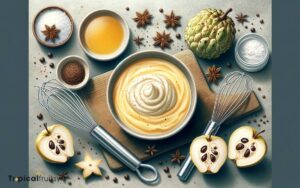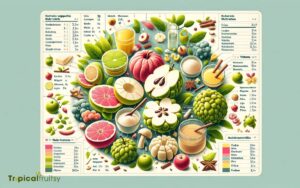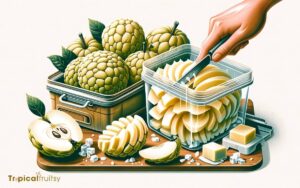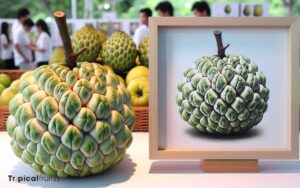How to Prepare Custard Apple? 5 Easy Steps!
Preparing a custard apple is an easy task that unlocks the sweet and nutritious qualities of this tropical fruit.
Start by selecting a ripe custard apple, which will feel slightly soft when pressed.
After a gentle wash and pat dry due to its delicate skin, cut the fruit in half to reveal the creamy insides dotted with black seeds. These seeds should be carefully removed as they are not edible.
The remaining sweet flesh can be enjoyed on its own or added to a variety of desserts, allowing you to indulge in the custard apple’s distinctive taste and creamy texture.
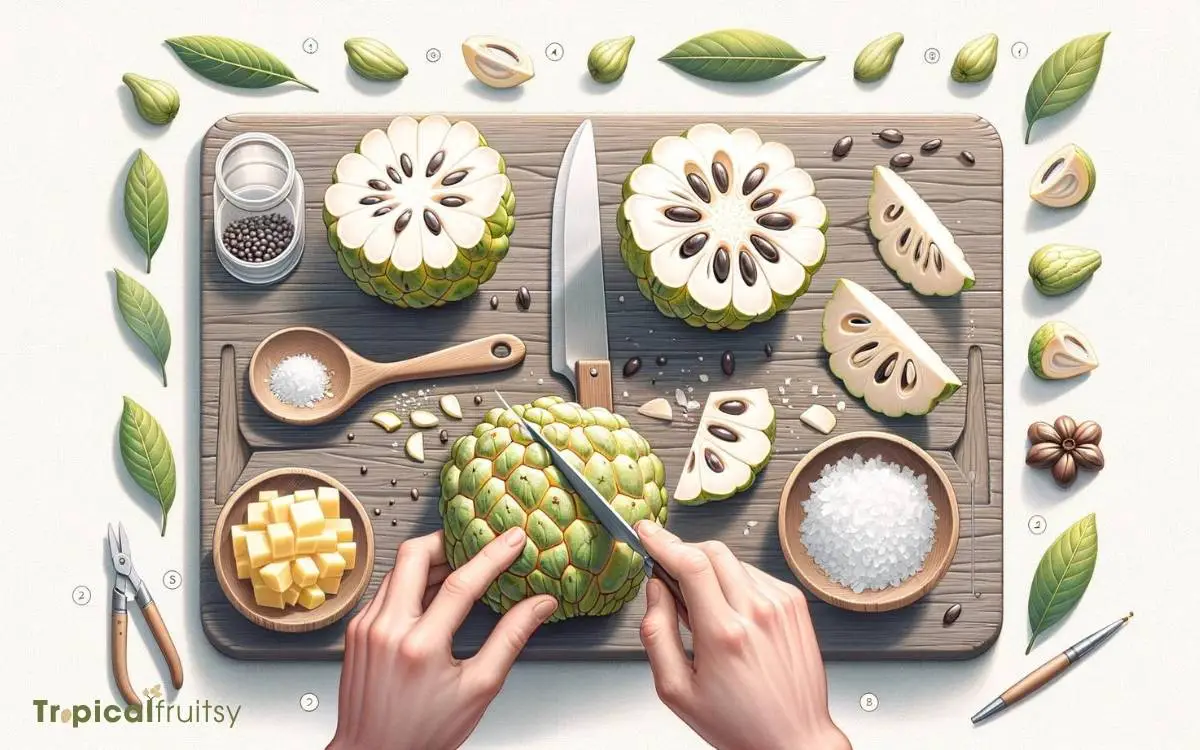
Key Takeaway
Step 1: Selecting the Right Fruit
In selecting the right custard apple for preparation, I always look for a fruit that’s firm yet yields slightly to gentle pressure.
The skin should be a pale green without any dark blemishes or bruises, which can indicate over-ripeness or damage.
I take a moment to inhale the scent; it should be subtly sweet and not overly strong, a sign that the fruit is at its peak. I gently cradle the custard apple in my palm, feeling for any soft spots which might suggest internal spoilage.
With a careful eye, I examine the stem; it should be intact, hinting that the fruit was carefully harvested.
A perfect custard apple feels like a treasure in my hand, promising a luscious sweetness within its creamy, tropical flesh.
Step 2: Washing and Drying
Before we get our hands sticky with the luscious flesh of the custard apple, I ensure its bumpy green skin is free from any impurities by giving it a thorough wash.
I’m mindful of the water’s warmth, as too hot can damage the skin while too cold mightn’t be as effective.
After rinsing, I pat the fruit dry with a soft cloth, employing a technique that’s gentle yet ensures no moisture is left to mar the fruit’s surface.
Water Temperature
I always ensure the water is lukewarm when washing custard apples, as extreme temperatures can damage their delicate skin. The perfect temperature is key to preserving their unique texture and preventing any bruising.
Here’s how I handle the process:
- I fill a bowl with lukewarm water, ensuring it’s neither too hot nor too cold to the touch.
- Gently, I place the custard apples into the water.
- With a soft brush or my fingers, I carefully cleanse the skin.
- I rinse the fruit under a gentle stream of lukewarm water.
- After washing, I lay them out on a clean towel to air dry, avoiding direct sunlight.
This meticulous approach helps maintain the custard apple’s integrity from kitchen to table.
Drying Methods
After washing the custard apples, I pat them dry with a soft towel to remove excess moisture. This step is crucial; it’s not just about hastily rubbing them down.
I take my time, ensuring that I absorb every droplet of water that clings to the dimpled skin. Why? Because any lingering moisture can be a breeding ground for bacteria, and I want to preserve the fruit’s integrity.
I meticulously work my way around the lobes, those bulbous segments that make the custard apple so distinctive.
Gently, I press the towel against the surface, respecting the fruit’s delicate nature. It’s almost like an art, finding a balance between thoroughness and care.
Once done, the apples aren’t just dry—they’re primed and ready for the next stage of preparation, be it eating fresh or incorporating into a luscious recipe.
Handling Techniques
Thorough drying, as I’ve described, sets the stage for the next crucial step in handling custard apples: a detailed examination of the washing and drying techniques.
To maintain the fruit’s integrity and ensure it’s ready for consumption or culinary use, I meticulously observe the following procedures:
- Gentle Washing: I carefully rinse the custard apple under cool, running water to remove any surface dirt or debris without damaging the skin.
- Soft Cloth Usage: I pat the fruit dry with a soft cloth, which minimizes bruising and absorbs excess moisture.
- Air Drying: I let the fruit sit on a clean drying rack for a few minutes to air dry completely, ensuring no moisture is trapped.
- Rotation: I rotate the fruit while drying to reach all crevices, preventing any water accumulation.
- Final Inspection: I conduct a final check for dampness or residue before proceeding with peeling or cutting.
Each step is performed with care to preserve the fruit’s delicate texture and flavor.
Step 3: Cutting the Custard Apple
I’ll now guide you through the precise art of slicing into a custard apple, ensuring every cut is intentional and effective.
Extracting the seeds with care is essential; I’ve perfected a technique that keeps the luscious flesh intact while discarding the hard seeds.
Ideal Cutting Technique
Typically, I cut a custard apple by first slicing it in half around the equator to reveal the creamy interior and seeds.
With a firm grip on the fruit, I gently guide my knife through the skin, feeling the subtle give of the ripe flesh beneath. It’s a delicate process; one must be careful not to crush the tender fruit.
- Use a sharp knife: This ensures a clean cut without squashing the fruit.
- Stabilize the fruit: Place it on a flat surface to prevent slipping.
- Slice gently: Apply minimal pressure to preserve the custard apple’s structure.
- Cut horizontally: Aim for a symmetrical division to make seed removal easier later on.
- Mind the juice: Be prepared for some spillage; it’s part of the custard apple’s charm.
Now, with the fruit open, I’m ready to move on to removing seeds safely.
Removing Seeds Safely
Once the custard apple is halved, I often use a spoon to gently scoop out the seeds, ensuring I don’t disturb the surrounding flesh too much. The seeds, glossy and black, are nestled within the creamy pulp like little jewels.
I find the process almost meditative, as I carefully wiggle the spoon near each seed and leverage it free. It’s important to be meticulous here; the seeds can be quite slippery and elusive.
I make sure to have a bowl nearby to collect them, keeping the work area clean and preventing any from slipping back into the custard apple’s custard-like interior.
After all, patience and precision here means an uninterrupted, purely indulgent experience later on. With the seeds removed, it’s time to think about the most delightful ways to serve this tropical treat.
Serving Suggestions
Having removed the seeds, I now turn to slicing the custard apple into wedges for an attractive presentation.
With a keen eye for detail, I ensure each piece showcases the creamy flesh against the vibrant green skin, making them not just delectable, but a feast for the eyes too.
Here are my serving suggestions:
- Drizzle honey over the wedges for a touch of natural sweetness.
- Sprinkle a dash of cinnamon to enhance the fruit’s nuanced flavors.
- Pair with a dollop of Greek yogurt for a creamy contrast.
- Arrange on a platter with assorted cheeses for a sophisticated dessert option.
- Garnish with fresh mint leaves to add a pop of color and refreshing aroma.
These ideas elevate the simple act of enjoying a custard apple to an experience that’s both gratifying and aesthetically delightful.
Step 4: Removing the Seeds
After cutting the custard apple into halves, I carefully press on the flesh to loosen the seeds for easy removal. The seeds, glossy and black, emerge from the creamy-white interior, contrasting starkly against the soft fruit.
I find it best to use my fingers for this task, as they’re gentle yet precise. I gingerly pick out each seed, feeling its smooth, hard surface.
It’s a meticulous process, but patience is key to ensuring that no fragments remain embedded in the custard-like pulp.
I’ve learned that rushing can cause the delicate flesh to break apart, so I take my time, coaxing the seeds out one by one.
As they accumulate on the side of my plate, the custard apple’s true, unadulterated flavor awaits, free from any accidental crunch.
Step 5: Scooping the Flesh
With the seeds removed, I use a spoon to scoop out the custard apple’s sweet flesh, ensuring I gather every bit of the creamy texture. The fruit’s interior is a treasure trove of flavor, and I’m careful not to waste a morsel.
Gently, I glide the spoon along the walls of the skin, watching as the flesh separates with a satisfying ease. It’s a delicate process, but wholly rewarding.
Here are some pointers for a successful scoop:
- Choose a ripe custard apple; it should yield slightly to pressure.
- Cut the fruit into two equal halves for easier handling.
- Use a gentle scooping motion to avoid bruising the delicate flesh.
- Leave the skin behind; only the flesh is desired.
- If necessary, use your fingers to remove any small bits of flesh clinging to the skin.
Each spoonful is a balance of skill and care, ensuring that I capture the full essence of this tropical delight.
Can I Use the Same Preparation Method for Custard Apples to Preserve Them?
Yes, you can preserve custard apple easily by using the same preparation method. Custard apples can be preserved by removing the seeds and blending the flesh with sugar, lemon juice, and freezing it in an airtight container. This method will help preserve custard apple easily for later use.
Serving Suggestions
I’ll now share some favorite ways to serve the prepared custard apple, ensuring your dessert is as delightful as it’s unique.
For a simple, elegant presentation, I like to spoon the creamy flesh atop a delicate puff pastry, dusting it with a whisper of cinnamon. The contrast of textures is sublime.
For something more refreshing, I’ll fold the custard apple into a chilled fruit salad, graced with a drizzle of honey-lime dressing. The subtle tang complements the sweetness beautifully.
If I’m feeling indulgent, I’ll blend the pulp with cream and freeze it into a luxurious custard apple ice cream. Each scoop is a velvety dream, an ode to the fruit’s luscious essence.
These serving suggestions elevate the custard apple from exotic curiosity to a versatile dessert star.
Storage Tips
Proper storage ensures that my custard apples maintain their freshness and flavor for as long as possible.
Here’s how I keep them in prime condition:
- Refrigerate Ripe Fruit: Once ripe, I place custard apples in a plastic bag and store them in the fridge to slow down the ripening process.
- Counter for Unripe Ones: I keep unripe custard apples on the counter at room temperature until they soften slightly.
- Avoid Cramming: I make sure not to overcrowd them to prevent bruising and to allow for adequate airflow.
- Check Regularly: I inspect them every other day for signs of over-ripening or spoilage.
- Consume Quickly After Cutting: Once I’ve cut into a custard apple, I eat it within a day or two, as it doesn’t last long after being exposed to air.
Conclusion
Having handpicked the heaviest, honey-hued custard apple, I carefully cleansed it, carved it open, and culled the countless kernels.
With gentle gestures, I gathered the creamy, custard-like core.
I creatively combined the scooped sweetness with spices, serving it splendidly as a succulent solo snack or as a delightful dessert dip.
Stored securely, my custard apple stash stands by, set to satisfy future sweet cravings with its silken, sumptuous spoonfuls.
What a splendidly simple, yet sensationally satisfying treat!

